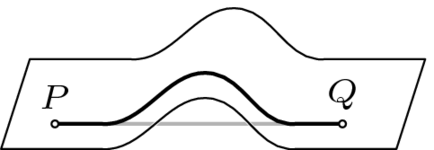Linear Algebra/Length and Angle Measures
Template:Navigation We've translated the first section's results about solution sets into geometric terms for insight into how those sets look. But we must watch out not to be mislead by our own terms; labeling subsets of of the forms and as "lines" and "planes" doesn't make them act like the lines and planes of our prior experience. Rather, we must ensure that the names suit the sets. While we can't prove that the sets satisfy our intuition— we can't prove anything about intuition— in this subsection we'll observe that a result familiar from and , when generalized to arbitrary , supports the idea that a line is straight and a plane is flat. Specifically, we'll see how to do Euclidean geometry in a "plane" by giving a definition of the angle between two vectors in the plane that they generate.
We can use that definition to derive a formula for the angle between two vectors. For a model of what to do, consider two vectors in .
Put them in canonical position and, in the plane that they determine, consider the triangle formed by , , and .
Apply the Law of Cosines, , where is the angle between the vectors. Expand both sides
and simplify.
In higher dimensions no picture suffices but we can make the same argument analytically. First, the form of the numerator is clear— it comes from the middle terms of the squares , , etc.
Note that the dot product of two vectors is a real number, not a vector, and that the dot product of a vector from with a vector from is defined only when equals . Note also this relationship between dot product and length: dotting a vector with itself gives its length squared .
Still reasoning with letters, but guided by the pictures, we use the next theorem to argue that the triangle formed by , , and in lies in the planar subset of generated by and .
This inequality is the source of the familiar saying, "The shortest distance between two points is in a straight line."
This result supports the intuition that even in higher-dimensional spaces, lines are straight and planes are flat. For any two points in a linear surface, the line segment connecting them is contained in that surface (this is easily checked from the definition). But if the surface has a bend then that would allow for a shortcut (shown here grayed, while the segment from to that is contained in the surface is solid).
Because the Triangle Inequality says that in any , the shortest cut between two endpoints is simply the line segment connecting them, linear surfaces have no such bends.
Back to the definition of angle measure. The heart of the Triangle Inequality's proof is the "" line. At first glance, a reader might wonder if some pairs of vectors satisfy the inequality in this way: while is a large number, with absolute value bigger than the right-hand side, it is a negative large number. The next result says that no such pair of vectors exists.
The Cauchy-Schwarz inequality assures us that the next definition makes sense because the fraction has absolute value less than or equal to one.
Template:AnchorThus vectors from are orthogonal (or perpendicular) if and only if their dot product is zero.
Exercises
Template:Linear Algebra/Book 2/Recommended Template:TextBox Template:Linear Algebra/Book 2/Recommended Template:TextBox Template:Linear Algebra/Book 2/Recommended Template:TextBox Template:TextBox Template:TextBox Template:Linear Algebra/Book 2/Recommended Template:TextBox Template:TextBox Template:Linear Algebra/Book 2/Recommended Template:TextBox Template:TextBox Template:TextBox Template:Linear Algebra/Book 2/Recommended Template:TextBox Template:Linear Algebra/Book 2/Recommended Template:TextBox Template:TextBox Template:TextBox Template:Linear Algebra/Book 2/Recommended Template:TextBox Template:TextBox Template:TextBox Template:TextBox Template:TextBox Template:TextBox Template:TextBox Template:TextBox Template:Linear Algebra/Book 2/Recommended Template:TextBox Template:TextBox Template:TextBox Template:TextBox Template:TextBox Template:Linear Algebra/Book 2/Recommended Template:TextBox Template:Linear Algebra/Book 2/Recommended Template:TextBox Template:TextBox Template:TextBox



